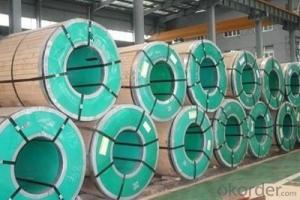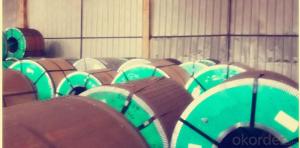Stainless Steel Coil 304 Hot/Cold Rolled 2B/BA/NO.1
- Loading Port:
- Guangzhou
- Payment Terms:
- TT OR LC
- Min Order Qty:
- 100 m.t.
- Supply Capability:
- 20000 m.t./month
OKorder Service Pledge
OKorder Financial Service
You Might Also Like
Hot Rolled Stainless Steel Coil 304
Annealing and Pickling No.1 Finish
Stainless steel is a production which not easy rust,acid resistance and corrosion resistance,so it is widely
used in light industry,heavy industry,daily necessities and the decoration industry.
Hot Rolled Stainless Steel Coil 304 Specifications
1.surface:NO.1
2.standard:JIS, AISI, GB
3.width: 0.55m, 0.65m, 1.0m, 1.22m, 1.5m, 2m or requirement
Hot Rolled Stainless Steel Coil 304 Chemical Composition:
(%):C=0.07, Mn=2.00, P=0.045, S=0.030, Si=0.075, Cr=17.5-19.5, Ni=8.0-10.5, N=0.10
Hot Rolled Stainless Steel Coil 304 Physical Properties
Tensile strength σb (MPa) ≥ 520
the conditions yield strength σ0.2 (MPa) ≥ 205,
elongation δ5 (%) ≥ 40
Reduction of ψ (%) ≥ 50,
hardness: ≤ 187
HB; ≤ 90
HRB; ≤ 200H
- Q:Can stainless steel strips be used for decorative purposes?
- Yes, stainless steel strips can be used for decorative purposes. They are often used in architecture, interior design, and various decorative applications due to their sleek and modern appearance. Additionally, stainless steel is highly durable, resistant to corrosion, and easy to clean, making it an excellent choice for decorative purposes.
- Q:Can stainless steel strips be used in the production of automotive exhaust systems?
- Indeed, the utilization of stainless steel strips proves to be feasible in the manufacturing process of automotive exhaust systems. The commendable resistance against corrosion, impressive capacity to withstand high temperatures, and remarkable durability render stainless steel a favored preference for exhaust systems. Such attributes make stainless steel strips the perfect choice for enduring the harsh conditions and extreme temperatures that exhaust systems are exposed to. Furthermore, the malleability and weldability of stainless steel strips allow for effortless formation into the required shapes and configurations essential for automotive exhaust systems.
- Q:What are the surface finishes available for stainless steel strips?
- Stainless steel strips offer a variety of surface finishes, each with its own distinct appearance and characteristics. Some commonly used finishes are as follows: 1. Mill Finish: This is the standard finish provided by the steel mill and features a smooth, unpolished surface. It is typically used when a specific finish is not necessary. 2. 2B Finish: Achieved through cold rolling and controlled annealing, this finish boasts a smooth, reflective surface. It is commonly utilized in applications that require excellent corrosion resistance. 3. No. 4 Finish: Also known as brushed or satin finish, this option involves mechanically polishing the stainless steel strip with abrasive belts or brushes. It results in a uniform, non-reflective surface with delicate parallel lines, making it ideal for decorative purposes. 4. BA Finish: Bright Annealed finish, abbreviated as BA, is obtained by annealing the stainless steel strip in a controlled environment and subsequently cold rolling it to achieve a bright, reflective surface. It provides a highly reflective finish suitable for decorative applications. 5. No. 8 Finish: Also referred to as a mirror finish, this finish involves mechanically polishing the stainless steel strip to create an extremely reflective surface. It is often used in architectural and decorative applications where a mirror-like appearance is desired. Moreover, there are specialized finishes available, such as embossed finishes that employ stamping patterns onto the surface, and patterned finishes that utilize chemical etching or laser engraving techniques to create unique designs. These finishes are frequently utilized for aesthetic purposes in areas such as interior design, signage, and automotive trim.
- Q:What are the standard dimensions of stainless steel strips?
- The standard dimensions of stainless steel strips can vary depending on the specific application and industry requirements. However, there are some common standard dimensions that are widely used. Stainless steel strips typically come in various widths ranging from 0.025 inches to 24 inches. The thickness of these strips can range from 0.001 inches to 0.1875 inches. Lengths can vary as well, but standard lengths are often available in coils or rolls of up to 100 feet. It is important to note that these dimensions are not fixed and can be customized based on the specific needs of the project or application.
- Q:Can stainless steel strips be used in pharmaceutical applications?
- Yes, stainless steel strips can be used in pharmaceutical applications. Stainless steel is highly corrosion resistant and has excellent mechanical properties, making it a suitable material for various pharmaceutical processes. It is commonly used in the manufacturing of pharmaceutical equipment, such as storage tanks, mixing vessels, and piping systems. Stainless steel strips are often used for fabricating components that require high strength, durability, and resistance to chemicals and cleaning agents. Additionally, stainless steel is non-reactive and does not leach any harmful substances, ensuring the integrity and purity of pharmaceutical products.
- Q:Are stainless steel strips suitable for elevator interiors?
- Yes, stainless steel strips are suitable for elevator interiors. Stainless steel is a durable and hygienic material that is resistant to corrosion, making it ideal for high-traffic areas like elevators. Additionally, stainless steel strips can also enhance the aesthetic appeal of the elevator interiors, providing a sleek and modern look.
- Q:What are the common uses of stainless steel strips in the HVAC industry?
- Stainless steel strips are widely used in the HVAC (Heating, Ventilation, and Air Conditioning) industry due to their excellent properties and versatility. Some of the common uses of stainless steel strips in this industry include: 1. Ductwork: Stainless steel strips are commonly used for fabricating ducts in HVAC systems. The ducts made from stainless steel strips are durable, corrosion-resistant, and can withstand high temperatures and pressure. They provide a reliable and long-lasting solution for air distribution in residential, commercial, and industrial buildings. 2. Heat exchangers: Stainless steel strips are often utilized in the construction of heat exchangers, which are essential components in HVAC systems. Heat exchangers made from stainless steel strips provide efficient heat transfer, ensuring effective heating or cooling of air or water. The corrosion resistance of stainless steel makes it suitable for handling different fluids and prevents equipment failure due to rust or corrosion. 3. Ventilation systems: Stainless steel strips are commonly used in the manufacturing of ventilation systems, including air handling units, exhaust fans, and air filters. These systems require materials that can withstand harsh environments and maintain proper airflow. Stainless steel strips offer resistance to corrosion, heat, and chemical exposure, making them ideal for constructing durable and efficient ventilation systems. 4. Pipe and tubing: Stainless steel strips are frequently used for manufacturing pipes and tubing in HVAC applications. These components transport fluids such as refrigerants, coolants, and condensate. Stainless steel strips provide excellent resistance to corrosion, which is crucial in preventing leaks and ensuring the longevity of the HVAC system. 5. Furnace parts: Stainless steel strips are used in the fabrication of various furnace components, including burners, heat shields, and combustion chambers. These parts are exposed to high temperatures, flames, and corrosive gases. Stainless steel strips offer high-temperature resistance, oxidation resistance, and durability, ensuring the efficient and safe operation of furnaces in HVAC systems. Overall, stainless steel strips are valued in the HVAC industry for their durability, corrosion resistance, high-temperature resistance, and versatility. They play a crucial role in ensuring the efficiency, reliability, and longevity of HVAC systems in diverse applications.
- Q:What are the different types of welding processes used for stainless steel strips?
- There are several types of welding processes commonly used for stainless steel strips, including TIG (Tungsten Inert Gas) welding, MIG (Metal Inert Gas) welding, and laser welding. TIG welding is known for its precision and produces high-quality welds, making it suitable for thin stainless steel strips. MIG welding is faster and more versatile, making it ideal for thicker stainless steel strips. Laser welding is a non-contact process that offers high-speed and high-quality welds, often used in automated production lines for stainless steel strips.
- Q:Are stainless steel strips resistant to chloride stress corrosion cracking?
- Yes, stainless steel strips are generally resistant to chloride stress corrosion cracking. Stainless steel is known for its excellent corrosion resistance properties, and this includes resistance to chloride stress corrosion cracking. This is due to the high levels of chromium present in stainless steel, which forms a protective oxide layer on the surface of the material, preventing the penetration of chloride ions and subsequent corrosion. However, it is important to note that the resistance to chloride stress corrosion cracking can vary depending on the specific type and grade of stainless steel used, as well as the specific environmental conditions in which the material is exposed. Therefore, it is always recommended to consult the manufacturer's specifications and guidelines to ensure the appropriate grade of stainless steel is selected for the intended application.
- Q:What are the common uses of stainless steel strips in the power generation industry?
- Due to their exceptional properties and durability, stainless steel strips find extensive use in the power generation industry. Here, we present some prevalent applications of stainless steel strips in this sector: 1. Turbines: The construction of turbine blades and rotors relies heavily on stainless steel strips. These components require materials with high strength, corrosion resistance, and the ability to withstand elevated temperatures. Stainless steel emerges as the ideal choice, ensuring the generation of power efficiently and reliably. 2. Heat exchangers: The power generation process heavily relies on heat exchangers, making stainless steel strips indispensable. These strips exhibit remarkable resistance to corrosion and high temperatures, enabling efficient heat transfer between various fluids within power plants. 3. Boiler components: Various boiler components, such as tubes, flues, and pressure vessels, commonly employ stainless steel strips in their fabrication. These strips possess corrosion resistance, high-temperature strength, and low maintenance requirements, rendering them reliable and cost-effective for power generation applications. 4. Exhaust systems: To safely and efficiently channel exhaust gases out of power generation facilities, stainless steel strips are frequently utilized in exhaust system construction. Ductwork, stacks, and chimneys made from stainless steel strips offer corrosion resistance and high-temperature tolerance. 5. Condensers: In power plants, stainless steel strips are crucial for manufacturing condenser tubes. These tubes facilitate the efficient transfer of heat from steam to cooling water, ensuring optimal power generation. Stainless steel's resistance to corrosion and fouling makes it an ideal material for condenser tubes, guaranteeing long-lasting reliability and performance. By incorporating stainless steel strips into power generation equipment, the industry benefits from enhanced efficiency, reliability, and longevity. These strips' properties ensure safe operation in demanding environments, ultimately promoting sustainable electricity production.
1. Manufacturer Overview |
|
|---|---|
| Location | |
| Year Established | |
| Annual Output Value | |
| Main Markets | |
| Company Certifications | |
2. Manufacturer Certificates |
|
|---|---|
| a) Certification Name | |
| Range | |
| Reference | |
| Validity Period | |
3. Manufacturer Capability |
|
|---|---|
| a)Trade Capacity | |
| Nearest Port | |
| Export Percentage | |
| No.of Employees in Trade Department | |
| Language Spoken: | |
| b)Factory Information | |
| Factory Size: | |
| No. of Production Lines | |
| Contract Manufacturing | |
| Product Price Range | |
Send your message to us
Stainless Steel Coil 304 Hot/Cold Rolled 2B/BA/NO.1
- Loading Port:
- Guangzhou
- Payment Terms:
- TT OR LC
- Min Order Qty:
- 100 m.t.
- Supply Capability:
- 20000 m.t./month
OKorder Service Pledge
OKorder Financial Service
Similar products
New products
Hot products
Related keywords






























